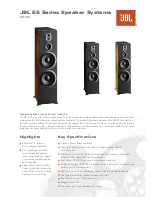
7
LSR6325P Features to Tackle the Problems in the Room
LSR
– Linear Spatial Reference Technology
JBL Developed Linear Spatial Reference Technology to optimize mid and high frequency accuracy at the
listening position where reflected sound comes into play. Meeting frequency response criteria for seventy-two
off-axis measurements, the LSR6325P ensures that not just the direct sound, but the reflected sound that
reaches you at the listening position is also smooth and accurate.
Boundary Compensation
- A Boundary Compensation switch restores accurate bass response when the
loudspeaker is wall mounted, positioned close to walls, corners, placed on work surfaces or console meter
bridge.
Magnetic Shielding
– The LSR6325P is magnetically shielded to allow use in close proximity to CRT video
and computer displays.
Mounting Options
– The LSR6325P enclosure includes mounting points to provide flexibility and allow you to
optimize placement, particularly in small environments. Mounting points are compatible with industry-stan-
dard mounting hardware.
Optional LSR6312SP Subwoofer with Room Mode Correction -
The use of an optional LSR6312SP
powered subwoofer in your LSR6325P system adds the powerful benefit of Room Mode Correction. The RMC
circuit in the LSR6312SP and the included RMC Calibration Kit allow you to identify and compensate for
troublesome low frequency standing waves. The result is clear extended bass response at the mix position in
any size room.
Set Up
Unpacking
– Caution: The high-frequency transducer is unprotected and can be damaged if touched while
unpacking the speaker. An easy way to safely unpack your monitors is to open the top of the box, keep the
filler piece on and roll the box upside down. The box can then be slipped off. This also works in reverse for
repacking the system.
Placement
– Speaker Placement
Listening Distance: In a stereo close-field application the speaker is typically placed 1 to 1.5 meters (3-5 feet)
from the listening position. In mid-field or surround sound applications, 2-3 meters is typical. The field in a
stereo listening application is optimized by arranging the speakers to form an equilateral triangle where the
distance between the two speakers equals the distance of each speaker to the listening position. Vertical vs.
Horizontal Placement: The LSR6325P system is designed for vertical orientation which provides broad lateral
dispersion and controlled vertical dispersion to optimize the size of the listening window and minimize reflec-
tions off the work surface and the ceiling. Horizontal placement will limit the size of the listening window and
increase reflections which can result in cancellation at high frequencies.
Angling towards the listening position: The LSR6325P should be angled so the center of the high frequency
transducer points directly at the listener’s ears.
������
������
������




































